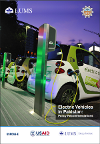 |
Energy Informatics Group |
Electric Vehicles in Pakistan: Policy RecommendationsThis report has been prepared by LUMS Energy Institute in collaboration with U.S.-Pakistan Centre for Advance Studies in Energy (USPCAS-E) at UET-Peshawar. It explores the feasibility of introducing Electric Vehicles (EVs) in Pakistan. The report utilizes the fact that Pakistan has the capacity to produce much more energy than the demand. Such an ability to produce surplus energy comes at a substantial financial cost to the declining economy of the country. Introducing EVs in Pakistan can utilize this surplus energy to limit these economic losses while at the same time add numerous associated socio-economic advantages. These socio-economic advantages include improved environmental conditions, creation of numerous employment opportunities, curtailment of the rising trade deficit and many more. Therefore, this report explores the potential of EVs in alleviating the condition of various sectors in Pakistan's economy and provides policy recommendations for incorporating EVs in the country. As a part of this report, we have designed three simulators which calculate the load due to addition of a number of EVs, the effect of the EV load on the power grid and the comparison of running cost of EV vs. FFV over a span of several years. Simulator 1: EV Load on the GridIn this simulator, the user can select a number of vehicles as per discretion. The user also has the leverage to choose in how much time does he wants to completely charge an EV. Additionally, the user can select the power in KW for the charger with which an EV has to be charged. Corresponding to the number of hours in which the user wishes to charge the vehicle, the time of the day can be selected in which the charging is to take place. Transmission and EV charging losses can also be set as per discretion of the user. Once all these parameters have been selected by the user, the simulator then calculates the load of charging respective number of EVs. The effect of the additional load due to EVs is then compared by the total national load. The simulator distinguishes the load with and without EVs. Simulator 2: EV vs. FFV Cost ComparisonThis simulator calculates the effect on the national load due to addition of a variable number of cars, busses, bikes and trucks that solely run on electric power. Once the user has selected the parameters, the simulator calculates and graphically illustrates the load due to each type of transport. The simulator also represents fuel saved due to utilization of electricity by addition of desired number of EVs. [Comparison on Costs for Electrical Vehicles vs. Fossil Fuel Vehicles] Simulator 3: Fuel Saved by EVsThis simulator calculates the cost per km of EV and its equivalent FFV. Once the desired inputs, specially the number of kilometres driven have been selected, the simulator calculates the price of both types of vehicles. [Fuel Saving by introducing percentage of EV into the Market] |
|
|
|
|
EIG website design by Muhammad Abdullah Zafar
|
|


